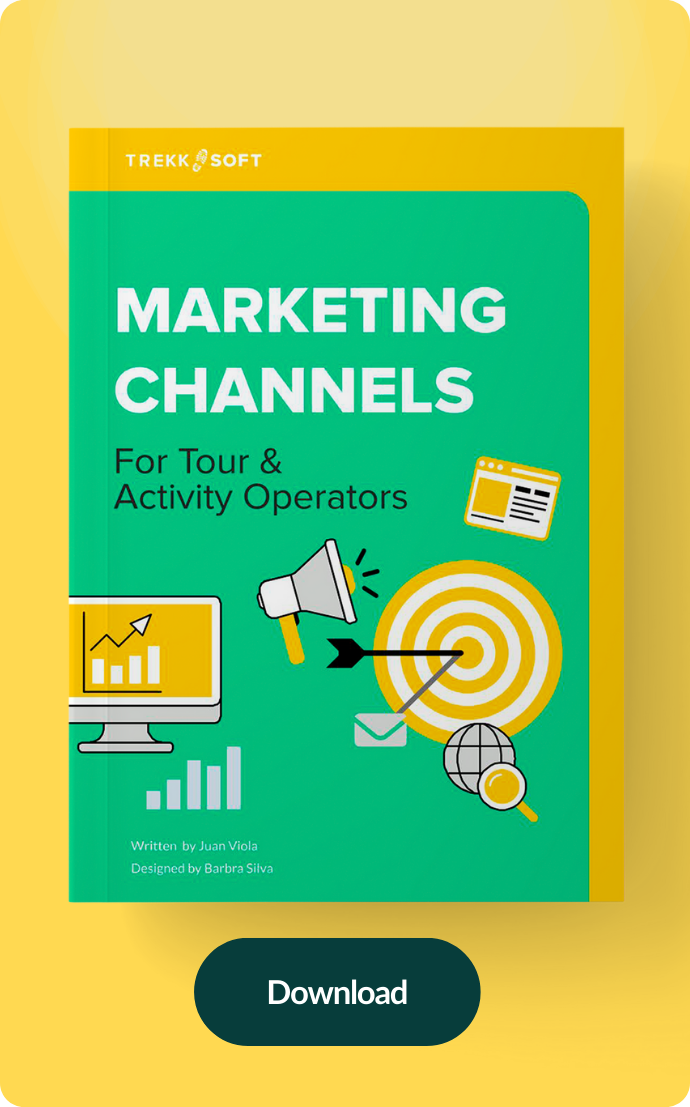Initially posted in 2018, this content has been updated for enhanced relevance, with the changes effective as of March, 2024.
Let's say you are a tour operator who offers paragliding to travelers from all over the world. You work in a busy city, so there are three other similar size tour companies providing paragliding activities in the same location that you run your tours. You know what makes your paragliding experience different from your competitors, but how can you let potential customers know?
A good description also helps you optimize your content to rank higher on marketplaces such as Tripadvisor. Recent Tripadvisor surveys suggest that users only consider the Top 5 options on a search. This means that delivering the information that customers are looking for is essential in many ways.
Most travelers won't have any knowledge or loyalty to your company. They will be browsing online marketplaces or search engines and will view your tours alongside your competitors, so you need to ensure that your listing stands out. This is why tour descriptions are so important as both an advert and a sales pitch.
Writing a tour description that sells
A tour description is the content that explains what your tour is and its unique selling points. The purpose of a tour description is to supply potential customers with details about the features of the tour, so they’re compelled to purchase their ticket.
But what is the information that you should add on a tour description? Too much information can be excessive, and too little information can be not enough for customers to choose your company. To help you build an effective tour description, that answers primary questions and doubts and influence your consumers’ purchasing decisions, here are tips to write a tour description that sells:
1. Who is your ideal customer?
Your tour description should appeal to your ideal customer, so you should have buyer personas based on your target market. Read: How to understand your customers by creating personas
Buyer personas (sometimes referred to as marketing personas) are fictional, generalized representations of your ideal customers. Personas help us all -- in marketing, sales, product, and services -- internalize the ideal customer we're trying to attract, and relate to our customers as real humans. Having a deep understanding of your buyer persona(s) is critical to driving content creation, product development, sales follow up, and really anything that relates to customer acquisition and retention. HubSpot
Once you know which buyer persona you would like to reach, you can select the right marketplace for this audience. Your tour description can then be designed to match the buyers preference by changing the tone and length of the content, images, features of the tour and what items are included. You can find out what is important to this persona by reviewing existing bookings and asking customers who meet these criteria for feedback. If you are looking to reach buyers from another country, it may be of value to have your listing professionally translated.
2. Photography is essential
In the digital age, photography is the first engagement tool we have when advertising tours and activities. It's what attracts the website user, and what will set you apart from your competition. You need to choose a featured image that is eye-catching, unique and makes a customer want to click and find out more. Look at what your competitors are using, and select something different so that your tour stands out. You should also change your photo from time-to-time to see if engagement increases or decreases. This way you can find which one works best.
Within your tour description, have 5-10 high-quality photos that showcase your tour; where customers will go, what they will see, and how much they will enjoy it.
It is worth investing in professional photography for your tour descriptions as photography could make or break a potential customer's decision. You can also use the same images on your website and social media channels to split the cost of purchase.
3. Explain your tour in the title
The title it’s one of the first things that customers will see, whether in a marketplace, search engines like Google or on your website. But what could set your tour title apart? If your service is paragliding in an adventure destination, your competitors will probably have 'Paragliding Interlaken' as their tour title, just like you.
To highlight your offers, in your title use your unique selling points to share the main features of your experiences. Keep in mind what are the most relevant and appealing aspects, as well as your target audience. Try words like exclusive or priority access, local or experienced guide, once-in-a-lifetime, incredible views, etc.
Does your tour include a drive to your destination? Do you offer food or a drink at the end of the trip? If so, add this in your title, but keep it short and catchy. If you’re not sure about the title, just remember that you can test your title. You can update the title according to the season, events and even offers.
4. What is unique about your tour?
The content of your tour description should be all about what makes your experience unique. If I book Paragliding in Interlaken, then I already have an idea of what it will entail. Tell me something different. Share what the experience will be like from start to finish, who my tour guide will be, where we will go, and why I need to book this tour. I always hear people say 'if you are ever going to paraglide, it needs to be in Interlaken.' This is a message that works. What could your message be?
When writing your content use keywords that will be relevant and searchable to bring more traffic to your tour page. You can use KeywordTool to search for which words and phrases you should use. I also recommend using a grammar checking site such as Grammarly to find any small typos, or to ask someone to review your listing before it goes live.
Read 5 tips to create SEO-friendly content.
5. Can the description be skimmed?
Most people who see your page will also be looking at 5-10 different activities and they may be using a mobile device. Your description should have the option to be skimmed quickly by the reader. You can achieve this by using bullet points to highlight the key features of the tour, followed by the full description to find out more.
Key features should be what makes your tour unique from your competitors. Here is an example:
-
20 minute scenic drive in a 4x4 through the Swiss Alps to your flight destination
-
Introduction and safety briefing with your pilot Tim who has be flying for over 15 years'
-
30 minute tandem paragliding over the beautiful Swiss Alps and Lake Thun, landing in the heart of Interlaken
-
20 photographs and a video so you can show everyone the proof
-
A high-five and beer to celebrate that you did this awesome experience!
Think about the format you are using to deliver your information. Big, long blocks of content can work for some types of content, but a description should focus on delivering easy-to-read content. So, focus on using clear titles and headings, writing short paragraphs, using lists and bullets, and highlighting keywords and phrases.
6. Tracking and analyzing
With any form of advertising, you should test and analyze your campaign. You can always try a new description, imagery, featured image or title.Try different versions over the course of 6-8 weeks and see which provides the best results. If your competitors copy your tour description style, then change again. Always stand out!
There are different ways to track your results. You can use Google Analytics 4 to monitor your website's performance, user behavior, and customer preferences. You can also integrate GA4 with your booking system to track conversions.
7. Ensure transparent pricing information
While prices might vary between your different services, keep in mind that you can be open about your pricing in all your offers and descriptions, creating a sense of trust and reliability in customers.
Make sure that your pricing information is clear and transparent. Share with customers all the elements that determine the final price they pay. For example, in transportation, you can add information like air-conditioned vans, modern helicopters, the type of safety material, or any other relevant information you can share.
Keep in mind that when a traveler searches OTAs, Google Things to do, and other websites other than yours, they can compare prices. Analyze your competitors and share clear information so customers can make an informed decision when buying.
Avoid hidden fees or ambiguous costs that might appear at checkout. Clearly outline what is included in the price and any additional options available.
8. Showcase customer reviews and testimonials
Sharing genuine customer reviews and testimonials in your tour descriptions can help you increase the reliability of your services.
You can share reviews in the content, such as, "Previously, customers have described the experience as breathtaking." Or integrate your booking system, such as TrekkSoft, with TripAdvisor to add reviews on your tours so that people know about your good services.
Read 6 simple ways to get more customer reviews for your business.
9. Engage with a persuasive call-to-action (CTA)
A strong call-to-action is essential to encourage potential customers to take the next step, whether booking a tour, signing up for a newsletter, or contacting you for more information.
Examples of effective CTAs include "Book Now," "Join Us for an Unforgettable Adventure," or "Discover Your Next Adventure Today!" You can test different CTAs over time to see which one generates more bookings.
Plus: Streamline your process with AI tools
Over the last year, new tools and artificial intelligence have emerged as the main discussion topics. While the use of AI is increasing, there is still much to learn about best usage practices.
Tools such as ChatGPT, Copy.ai, and Jasper can help you streamline your content creation process. These AI-powered platforms can assist you in generating engaging and persuasive descriptions, effective CTAs, and general content.
But do you know how to use ChatGPT? To get the most out of the AI tool, there are different best practices for writing prompts, such as using step-by-step or bullet-point instructions, being clear and direct, and experimenting with other directions.
Learn more about leveraging AI tools to enhance your tour descriptions and drive sales. Join our ChatGPT webinar featuring Kelsey Tonner of Guest Focus, as we delve into the art of crafting compelling travel descriptions for maximum sales effectiveness.




